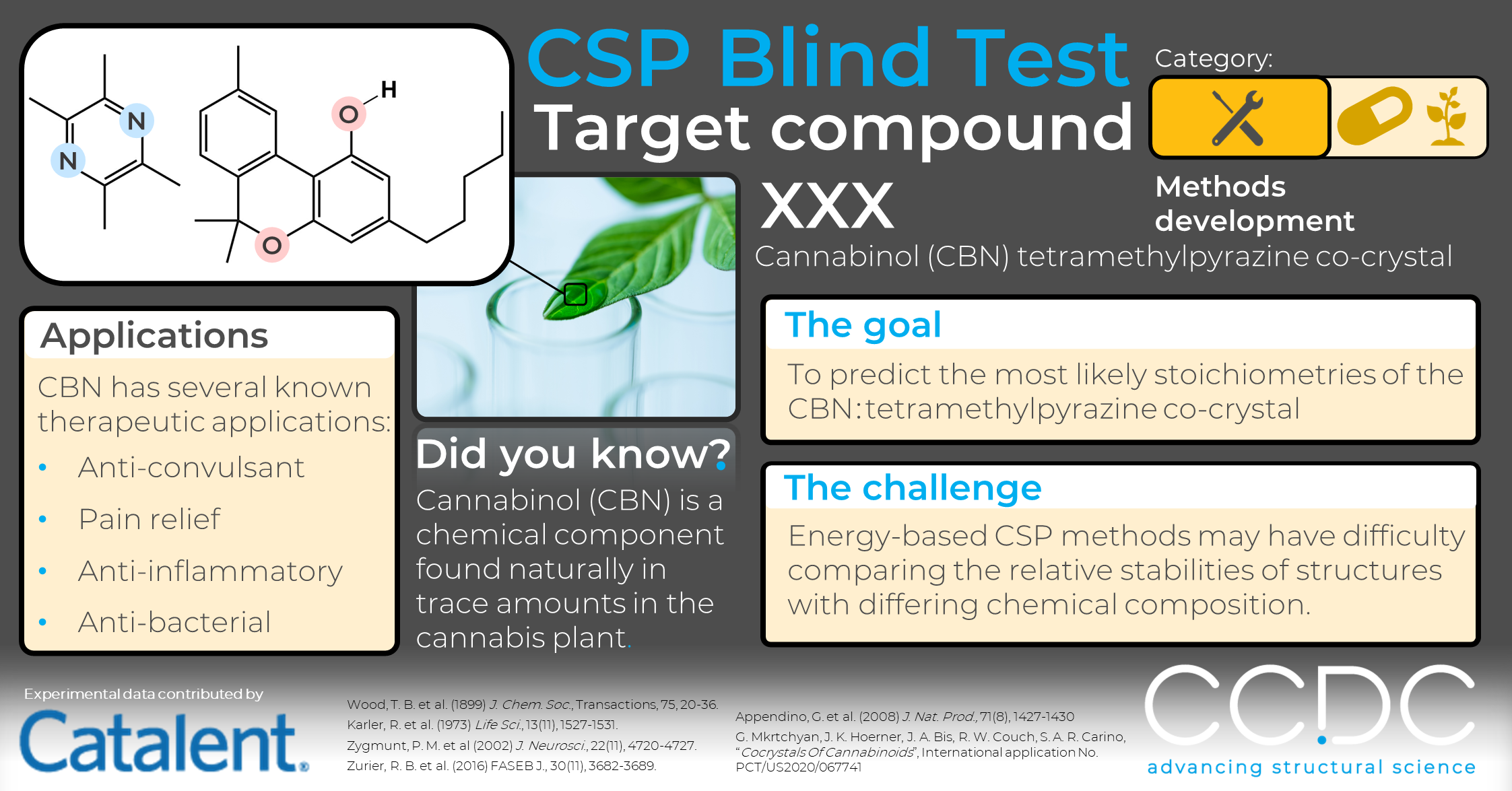CSP Blind Test Structure Reveal – Target XXX
Can crystal structure prediction (CSP) be used to computationally design multi-component materials? This is the question that target compound XXX poses to participants in this current CSP Blind Test.
OK, maybe not a test of the complete design process (as CSP methods are not quite that evolved… yet!), but this challenge is a huge step towards this by testing whether CSP can predict the correct molecular stoichiometry of a co-crystal.
Here we reveal the 2D chemical structure of the target compound, the challenging task given to Blind Test participants, and some information on the experimental data providers of this compound.
Revealing the target compound structures
For the first time since the initial CSP Blind Test in 1999, we are releasing the 2D chemical structures of the target compounds to the public through our website and social media platforms. We hope that this will showcase to the wider community the types of systems that CSP methods are applicable to, but more importantly, expose the challenges that CSP currently faces in terms of both computational hardware limitations (due to molecular size) and chemical complexity, and encourage wider participation for finding suitable solutions.

The structure

Target compound XXX is a tetramethylpyrazine co-crystal of cannabinol (CBN), a naturally occurring cannabinoid. CBN has been shown to have several therapeutic applications such as pain relief,[1] and anti-convulsant, anti-inflammatory, and anti-bacterial properties,[2-4] though from a quick search of the literature it appears to have been a lot less studied than it’s better known counter-parts, THC and CBD, (a Web of Science search of publication title names gave 4010 hits for ‘tetrahydrocannabinol, 2143 hits for ‘cannabidiol’, and only 179 hits for ‘cannabinol’) so there may still be a lot of science yet to be explored for this cannabinoid!
The challenge
Participants are asked to submit
- a list containing up to 1500 predicted structures
- a list of 100 predicted structures ranked in order of likelihood of observation
- a statement outlining the most likely observed stoichiometries of the system based on their submitted results.
The CCDC will analyse whether the experimentally observed forms are present in each list, whether they are ranked within the most likely observed, and whether the participants predict the correct observed stoichiometries.
Why is this task so challenging?
What makes this task a new challenge compared with any other from the CSP Blind Tests is that participants will have to assess the relative likelihood of observation of structures with differing stoichiometries (translating to an overall differing chemical composition). For the CSP methods based on calculating relative energetics of a system, this is like asking participants to compare apples with oranges (which is bananas!).
The target compound providers
Unlike the remainder of target compounds in this 7th CSP Blind Test, we are revealing the providers of the experimental data given to us for this system.
The solid-state team from Catalent, a pharmaceutical CRO, has not only provided this system for use in the CSP Blind Test, but have also carried out an explorative polymorph screen on the system to provide a thorough search for polymorphic forms and stoichiometries, ensuring there is high quality data available for those identified. A patent on this system is expected to be published later in 2021.[5]
Commenting on the challenge set for this system, the team led by Joanna Bis and Stephen Carino have said:
“We are excited to present a real-life challenge of a greater complexity that will facilitate the development and advancement of CSP methodologies. Potentially, having CSP methods which can predict probable stoichiometric products from a 2D molecular structures can significantly impact experimental screening strategies, making such screening more productive and efficient.”
What’s next?
This challenge has an early deadline (29th June 2021), so look out for a blog post soon after where we can reveal how many participant teams took on this challenge and submitted their results!
References:
[1] Zygmunt, Peter M., David A. Andersson, and Edward D. Högestätt. “Δ9-Tetrahydrocannabinol and cannabinol activate capsaicin-sensitive sensory nerves via a CB1 and CB2 cannabinoid receptor-independent mechanism.” Journal of Neuroscience 22.11 (2002): 4720-4727
[2] Karler, Ralph, William Cely, and Stuart A. Turkanis. “The anticonvulsant activity of cannabidiol and cannabinol.” Life Sciences 13.11 (1973): 1527-1531
[3] Zurier, Robert B., and Sumner H. Burstein. “Cannabinoids, inflammation, and fibrosis.” The FASEB Journal 30.11 (2016): 3682-3689
[4] Appendino, Giovanni, et al. “Antibacterial cannabinoids from Cannabis sativa: a structure− activity study.” Journal of natural products 71.8 (2008): 1427-1430
[5] Gnel MKRTCHYAN, Joshua K. HOERNER, Joanna A. BIS, Ricky W. COUCH, and Stephen A.R. CARINO, “Cocrystals Of Cannabinoids”, International application No. PCT/US2020/067741